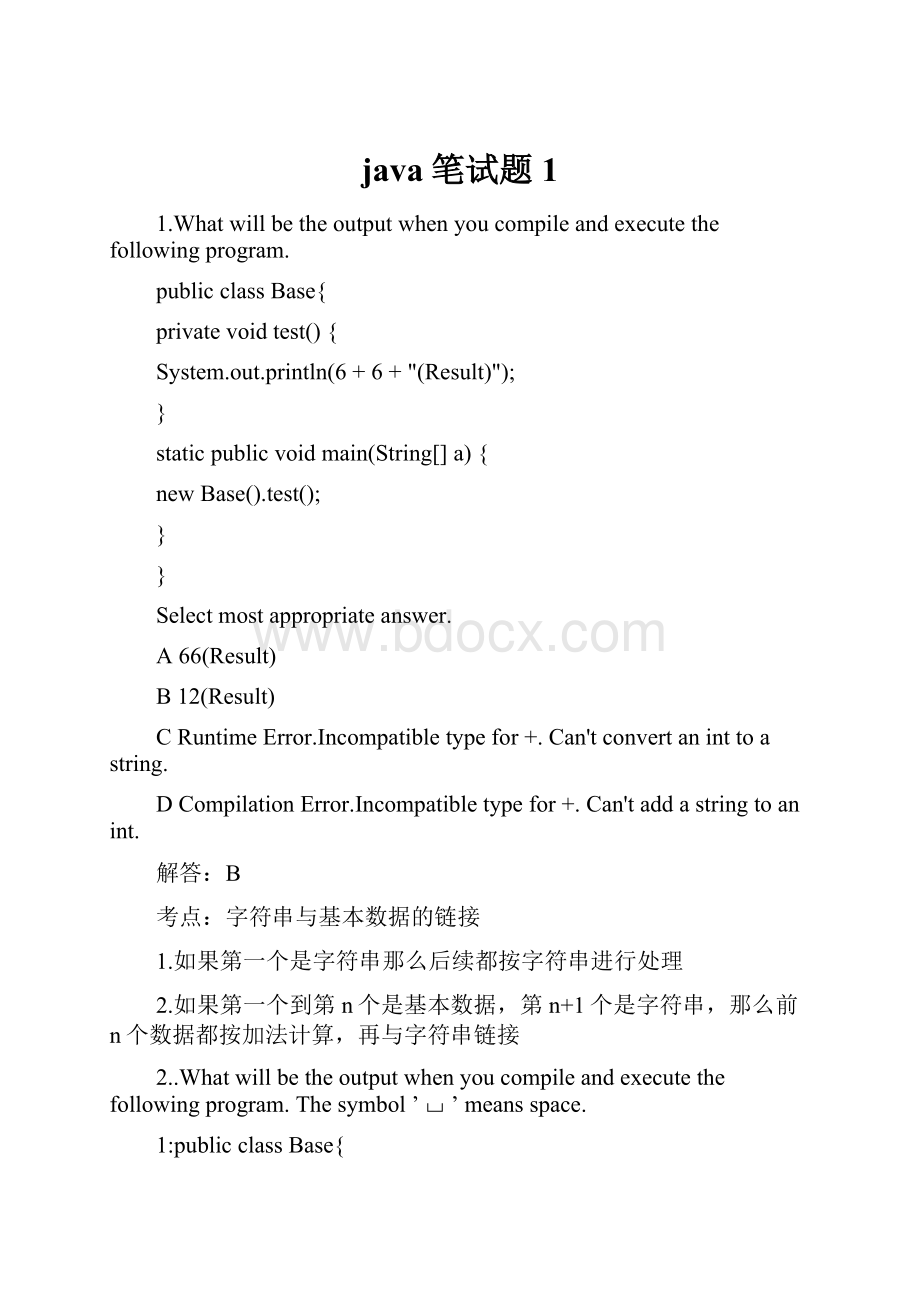java笔试题1.docx
《java笔试题1.docx》由会员分享,可在线阅读,更多相关《java笔试题1.docx(12页珍藏版)》请在冰豆网上搜索。

java笔试题1
1.Whatwillbetheoutputwhenyoucompileandexecutethefollowingprogram.
publicclassBase{
privatevoidtest(){
System.out.println(6+6+"(Result)");
}
staticpublicvoidmain(String[]a){
newBase().test();
}
}
Selectmostappropriateanswer.
A66(Result)
B12(Result)
CRuntimeError.Incompatibletypefor+.Can'tconvertaninttoastring.
DCompilationError.Incompatibletypefor+.Can'taddastringtoanint.
解答:
B
考点:
字符串与基本数据的链接
1.如果第一个是字符串那么后续都按字符串进行处理
2.如果第一个到第n个是基本数据,第n+1个是字符串,那么前n个数据都按加法计算,再与字符串链接
2..Whatwillbetheoutputwhenyoucompileandexecutethefollowingprogram.Thesymbol’⌴’meansspace.
1:
publicclassBase{
2:
3:
privatevoidtest(){
4:
5:
StringaStr="⌴One⌴";
6:
StringbStr=aStr;
7:
aStr.toUpperCase();
8:
aStr.trim();
9:
System.out.println("["+aStr+","+bStr+"]");
7:
}
8:
9:
staticpublicvoidmain(String[]a){
10:
newBase().test();
11:
}
12:
}
Selectmostappropriateanswer.
A[ONE,⌴One⌴]
B[⌴One⌴,One]
C[ONE,One]
D[ONE,ONE]
E[⌴One⌴,⌴One⌴]
解答:
E
通过StringbStr=aStr;这句代码使bStr和aStr指向同一个地址空间。
String类是定长字符串,调用一个字符串的方法以后会形成一个新的字符串。
3.Java语言中,String类的indexOf()方法返回的类型是?
A、Int16B、Int32C、intD、long
解答:
C
indexOf方法的声明为:
publicintindexOf(intch)
返回指定字符在字符串中第一次出现的索引,如果未出现该字符,则返回-1
4..执行下列代码后,哪个结论是正确的String[]s=newString[10];
A.s[9]为null;
B.s[10]为"";
C.s[0]为未定义
D.s.length为10
解答:
AD
s是引用类型,s中的每一个成员都是引用类型,即String类型,String类型默认的值为null,s数组的长度为10。
5.Given:
publicclassTest{
publicstaticvoidmain(String[]args){
Stringstr=NULL;
System.out.println(str);
}
}
Whatistheresult?
A.NULL
B.Compilationfails.
C.Thecoderunswithnooutput.
D.Anexceptionisthrownatruntime.
解答:
B
null应该小写
6、Given:
publicclassTest{
publicstaticvoidmain(Stringargs[]){
classFoo{
publicinti=3;
}
Objecto=(Object)newFoo();
Foofoo=(Foo)o;
System.out.println(foo.i);
}
}
Whatistheresult?
A.Compilationwillfail.
B.Compilationwillsucceedandtheprogramwillprint“3”
C.CompilationwillsucceedbuttheprogramwillthrowaClassCastExceptionatline6.
D.CompilationwillsucceedbuttheprogramwillthrowaClassCastExceptionatline7.
解答:
B
考点:
局部内部类的使用
局部内部类定义在方法中,作用域相当于局部变量的作用域
7、Given:
publicclassTest{
publicstaticvoidmain(String[]args){
Stringfoo=“blue”;
Stringbar=foo;
foo=“green”;
System.out.println(bar);
}
}
Whatistheresult?
A.Anexceptionisthrown.
B.Thecodewillnotcompile.
C.Theprogramprints“null”
D.Theprogramprints“blue”
E.Theprogramprints“green”
解答:
D
采用Stringfoo=“blue”定义方式定义的字符串放在字符串池中,通过Stringbar=foo;
他们指向了同一地址空间,就是同一个池子,当执行foo=“green”;foo指向新的地址空间。
8.下面哪个是正确的?
()
A.Stringtemp[]=newString{"a""b""c"};
B.Stringtemp[]={"a""b""c"};
C.Stringtemp={"a","b","c"};
D.Stringtemp[]={"a","b","c"};
解答:
D
A.Stringtemp[]=newString[]{"a","b","c"};
B.Stringtemp[]={"a","b","c"};
9.关于java.lang.String类,以下描述正确的一项是()
A.String类是final类故不可以继承;
B.String类是final类故可以继承;
C.String类不是final类故不可以继承;
D.String类不是final类故可以继承;
解答:
A
String类是final的,在java中final修饰类的不能被继承
10.从下面四段(A,B,C,D)代码中选择出正确的代码段()
A.abstractclassName{
privateStringname;
publicabstractbooleanisStupidName(Stringname){}
}
B.publicclassSomething{
voiddoSomething(){
privateStrings="";
intl=s.length();
}
}
C.publicclassSomething{
publicstaticvoidmain(String[]args){
Othero=newOther();
newSomething().addOne(o);
}
publicvoidaddOne(finalOthero){
o.i++;
}
}
classOther{
publicinti;
}
D.publicclassSomething{
publicintaddOne(finalintx){
return++x;}
}
解答:
C
A..抽象方法不能有方法体
B.方法中定义的是局部变量,不能用类成员变量修饰符private
D.final修饰为常量,常量的值不能被改变
11Strings=“Example”;
合法的代码由哪些?
A)s>>>=3B)s[3]=“X”C)inti=s.length()D)s=s+10
解答:
CD
A.移位运算,要是整数类型。
B.s不是数组
C.String类取长度的方法为:
length()
D.字符串相加
12.已知表达式intm[]={0,1,2,3,4,5,6};
下面哪个表达式的值与数组下标量总数相等?
()
A.m.length()
B.m.length
C.m.length()+1
D.m.length+1
解答:
B
解答:
数组下标是从零开始的,但是数据下标的总量和数据长度相同。
只有String类型才有length()方法,其他的类型都是length属性
13.给出如下代码:
)(
classTest{
privateintm;
publicstaticvoidfun(){
//somecode„
}
}
如何使成员变量m被函数fun()直接访问?
()
A.将privateintm改为protectedintm
B.将privateintm改为publicintm
C.将privateintm改为staticintm
D.将privateintm改为intm
解答:
C
静态的方法中可以直接调用静态数据成员
14.下述代码的执行结果是
classSuper{
publicintgetLength(){return4;}
}
publicclassSubextendsSuper{
publiclonggetLength(){return5;}
publicstaticvoidmain(String[]args){
Supersooper=newSuper();
Supersub=newSub();
System.out.printIn(sooper.getLength()+“,”+sub.getLength()};
}
}
A.4,4
B.4,5
C.5,4
D.5,5
E.代码不能被编译
解答:
E
方法重写返回值类型与父类的一致
15.指出下列程序运行的结果
publicclassExample{
Stringstr=newString("good");
char[]ch={'a','b','c'};
publicstaticvoidmain(Stringargs[]){
Exampleex=newExample();
ex.change(ex.str,ex.ch);
System.out.print(ex.str+"and");
System.out.print(ex.ch);
}
publicvoidchange(Stringstr,charch[]){
str="testok";
ch[0]='g';
}
}
Agoodandabc
Bgoodandgbc
Ctestokandabc
Dtestokandgbc
解答:
B
数组和字符串都是引用类型。
Java中参数传递是基于值的传递:
基本数据:
传递的是实际的值
引用类型:
传递的是地址值
16.Strings=newString(“hello”);
Stringt=newString(“hello”);
charc[]={‘h’,’e’,’l’,’l’,’o’};
下列哪些表达式返回true?
A.s.equals(t);
B.t.equals(c);
C.s==t;
D.t.equals(newString(“hello”));
E.t==c;
解答:
AD
String类的equals方法已经覆盖了Object类的equals方法,比较的是两个字符串的内容是否相等,双等号比较的是两个对象的内存地址是否相等
17.类Teacher和Student是类Person的子类;
Teachert;
Students;
//tandsareallnon-null.
if(tinstanceofPerson){s=(Student)t;}
最后一条语句的结果是:
A.将构造一个Student对象;
B.表达式是合法的;
C.表达式是错误的;
D.编译时正确,但运行时错误。
解答:
D
instanceof是Java的一个二元操作符,它的作用是测试它左边的对象是否是它右边的类的实例,返回boolean类型的数据。
Teahcer和Student之间没有继承关系不能做强制类型转换。
18.下面关于变量及其范围的陈述哪些是不正确的():
A.实例变量是类的成员变量
B.实例变量用关键字static声明
C.在方法中定义的局部变量在该方法被执行时创建
D.局部变量在使用前必须被初始化
解答:
BC
B.由static修饰的变量称为类变量或是静态变量
C.方法加载的时候创建局部变量
19.编译运行以下程序后,关于输出结果的说明正确的是():
publicclassConditional{
publicstaticvoidmain(Stringargs[]){
intx=4;
System.out.println(“valueis“+((x>4)?
99.9:
9));
}
}
A、输出结果为:
valueis99.99
B、输出结果为:
valueis9
C、输出结果为:
valueis9.0
D、编译错误
解答:
C
三目运算符中:
第二个表达式和第三个表达式中如果都为基本数据类型,整个表达式的运算结果由容量高的决定。
99.9是double类型而9是int类型,double容量高。
20.以下关于面向对象概念的描述中,不正确的一项是()。
(选择1项)
A.在现实生活中,对象是指客观世界的实体
B.程序中的对象就是现实生活中的对象
C.在程序中,对象是通过一种抽象数据类型来描述的,这种抽象数据类型称为类(class)
D.在程序中,对象是一组变量和相关方法的集合
解答:
B